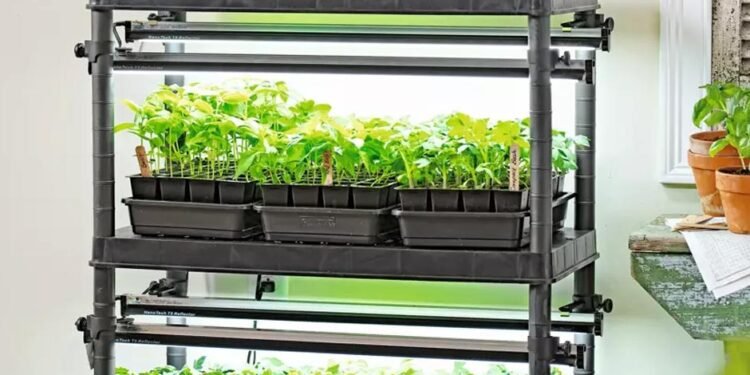Indoor gardening has become an increasingly popular hobby for plant enthusiasts, allowing them to cultivate a variety of crops right in the comfort of their homes. One of the most rewarding experiences is growing lettuce from seeds using LED grow lights. This method provides a cost-effective and efficient way to ensure a bountiful harvest of fresh, crisp lettuce leaves. In this guide, we’ll explore the steps and tips for successfully nurturing lettuce indoors, sharing insights from the perspective of an ordinary grower.
Getting Started with Indoor Lettuce Cultivation
Choosing the Right Seeds
When embarking on your green journey of lettuce cultivation, it is crucial to carefully select the perfect lettuce seeds. This is the very first and vital step towards a successful harvest. To ensure optimal results, it is recommended to choose high-quality, organic seeds from reputable suppliers or trusted local nurseries. Some excellent choices for indoor lettuce cultivation include popular varieties such as Butterhead, Romaine, or Looseleaf lettuce.
Creating the Ideal Environment
After obtaining the ideal lettuce seeds, the next step is to create the perfect growing environment. This entails selecting a suitable container with proper drainage to ensure proper water flow and prevent waterlogging. Once the container is ready, it’s time to fill it with nutrient-rich soil that will provide the necessary nourishment for the lettuce plants to thrive. Sow the seeds into the soil according to the instructions provided on the seed packet, ensuring to follow the recommended spacing and depth. To promote healthy growth, it is important to maintain a consistent moisture level in the soil, making sure it is neither too dry nor overly waterlogged.
Introducing LED Grow Lights
To optimize the growth and development of your indoor lettuce plants, the use of LED grow lights is highly recommended. These energy-efficient lights play a pivotal role in replicating the natural sunlight that plants need for photosynthesis and overall growth. For more information, you can learn about them here. When installing the LED grow lights, it is crucial to position them above the seedlings at an optimal distance. This will prevent any potential issues such as overheating or stunted growth, ensuring that the lettuce plants receive the perfect amount of light for their development
LED grow lights have gained a reputation for their effectiveness in providing the ideal spectrum of light for plant photosynthesis. Brands such as Batagrowlight and Boyagrowlight are well-known for their high-quality LED grow lights that have been proven to enhance the growth and productivity of indoor lettuce cultivation. By incorporating these lights into your setup, you can significantly improve the success rate of your lettuce cultivation project.
Nurturing Your Lettuce Seedlings
Managing Light Exposure
To ensure optimal growth during the germination and seedling stages, lettuce requires approximately 12 to 16 hours of light exposure daily. It is recommended to use a timer to establish a consistent light schedule, which will provide the plants with the necessary conditions to thrive. Additionally, rotating the trays regularly will help guarantee that all plants receive an equal amount of light, promoting uniform growth and development.
Regulating Temperature and Humidity
Creating and maintaining the appropriate environmental conditions is crucial for the healthy growth of lettuce. It is recommended to aim for a temperature range of 60-70°F (15-21°C) to provide the ideal climate for lettuce cultivation. Additionally, maintaining humidity levels around 40-50% will contribute to the overall well-being of the plants. Adequate air circulation should also be ensured to minimize the risk of diseases and promote robust development.
Watering Wisely
Proper watering techniques are essential for the successful cultivation of lettuce. It is important to avoid overwatering, as excessive moisture can lead to root rot and other problems. Instead, it is advisable to water the lettuce plants when the top layer of soil feels dry to the touch. This will help maintain the optimal moisture level for the plants without causing any damage. Additionally, it is recommended to use a gentle watering method to minimize any disruption to the delicate seedlings and ensure their healthy growth.
Transplanting and Harvesting
Transferring Seedlings
Once the seedlings have reached a suitable size, typically around 2-3 inches, it is time to carefully transfer them into larger containers or directly into your garden. This step is crucial to ensure that the plants have enough space to grow and thrive.
Monitoring Growth Progress
To ensure the healthy development of your lettuce plants, it is important to regularly monitor their growth progress. Keep an eye out for any signs of pests or nutrient deficiencies that may hinder their growth. If needed, you can adjust the intensity of the LED grow light to provide the optimal amount of light. Additionally, consider using a balanced liquid fertilizer to provide the necessary nutrients for their optimal development.
Harvesting Your Bounty
The exciting moment of harvesting your homegrown lettuce will arrive within 30 to 60 days, depending on the specific variety you are growing. When it’s time to harvest, start by picking the outer leaves first, allowing the inner leaves to continue growing. This method ensures a continuous supply of fresh and delicious lettuce for your table, providing you with a bountiful harvest that you can enjoy throughout the growing season.
Additional Tips for Success
- Companion Planting: One effective strategy to consider is companion planting. By strategically planting herbs like basil or chives alongside your main crops, you can not only enhance the flavor of your harvest but also naturally deter pests.
- Soil Quality Enhancement: To ensure optimal growth and yield, it is recommended to invest in a high-quality potting mix or create a custom blend. By incorporating nutrient-rich compost into your soil, you can significantly improve its fertility and provide essential nourishment to your plants.
- Access to Educational Resources: Expand your knowledge and gain valuable insights by exploring various educational resources. Platforms like Hempful Farms and Farmers Classic offer expert advice, gardening tips, and a supportive community to help you navigate any challenges you may encounter along your gardening journey.
Conclusion
Embarking on the journey of growing lettuce indoors from seeds with LED grow lights is a fulfilling endeavor for any gardening enthusiast. By providing the right conditions and incorporating insights from experienced growers, you can enjoy a continuous harvest of fresh, homegrown lettuce. Remember, patience and dedication are key ingredients in the recipe for a successful indoor lettuce garden. Happy growing!












